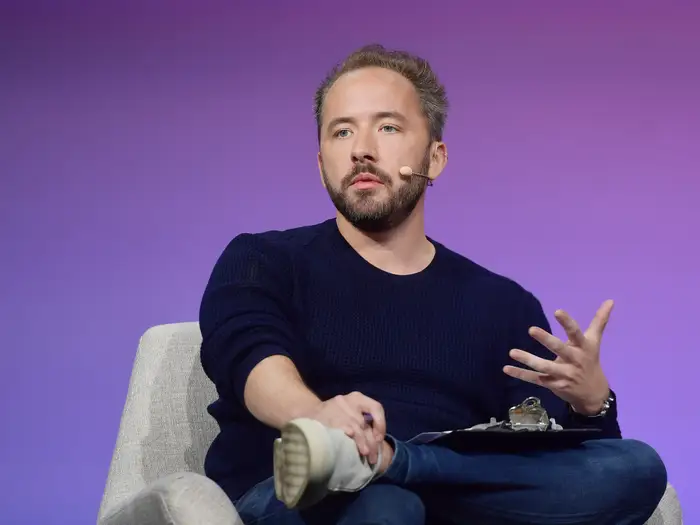From Thumb Drive Frustration to Billion-Dollar Vision: How Drew Houston Built and Rebuilt Dropbox

In the pantheon of Silicon Valley origin stories, few are as personal—and quietly revolutionary—as that of Drew Houston. The Dropbox co-founder and CEO didn’t set out to create a billion-dollar company. He just wanted to avoid forgetting his thumb drive.
In a candid conversation on The Social Radars podcast, Dropbox CEO Drew Houston shared the full arc of his entrepreneurial journey, what started as a side project to sync files between his laptop and desktop eventually grew into one of the most iconic startups of the Web 2.0 era, navigating competition from tech giants, investor skepticism, and a brutal public perception pivot. And Drew? He’s still at the helm—eighteen years later—with more clarity and purpose than ever.
Here’s how Drew Houston went from an obsessed coder on a Chinatown bus to a public company CEO rethinking how knowledge workers work.
📍 "I never want to have this problem again."
The original spark for Dropbox came in the most analog way possible. Drew, then working on an SAT prep startup, boarded a bus from Boston to New York intending to get work done—only to realize he’d left his USB drive behind.
“There was no Wi-Fi, no iPhone, no Netflix. I was just stuck on that bus for hours, hating myself for being disorganized,” he recalled. That moment led him to start building a tool—for himself—so he'd never face that issue again.
It wasn’t a startup idea yet. But it became one.
🧬 A Founder’s Persistence (And Slight Annoyance)
Drew’s first YC application, with the SAT company, was rejected. But after seeing friends like Adam Smith and Kyle Vogt (of Justin.tv) join Y Combinator and move to California, he was hooked. “I had major FOMO,” he admits.
He became known among YC circles as “that guy” who kept showing up uninvited, demoing early versions of Dropbox at parties and startup school events—even when Paul Graham hadn’t invited him.
It paid off.
Paul eventually emailed him to interview—but suggested he find a co-founder first. That led Drew back to MIT, where he met Arash Ferdowsi. Arash dropped out within days to join Drew, and they pitched YC together.
💡 "The product actually worked."
Dropbox stood out at demo day for one simple reason: it worked.
Investors had seen countless file storage solutions that failed—flaky syncing, lost data, clunky UX. But Dropbox was different. Drew and Arash had obsessed over the details: green checkmarks, intuitive UI, icon overlays. “We basically used malware techniques to hack the Finder on Mac,” Drew admits. “But it worked.”
Their demo ended with them deleting their pitch deck live… and then restoring it with Dropbox.
Investors noticed.
💰 The Million-Dollar Rug Deal
After demo day, investor Pejman Nozad (then operating out of a Persian rug store in Palo Alto) chased Arash up the aisle—speaking Farsi. He introduced the team to Sequoia Capital, setting off a whirlwind that led to a $1.2M seed deal with Sequoia, negotiated in their unfurnished apartment over Odwalla juices.
They watched their Bank of America balance go from $60 to $1.2 million. “I didn’t even know if our account could hold that much,” Drew laughed.
🧠 Competing with Giants, Facing Obsolescence
Dropbox's next chapter wasn’t all up and to the right.
In 2011, Steve Jobs publicly dismissed Dropbox as “a feature, not a product.” Earlier, he had offered to acquire the company—and warned them about their lack of distribution power.
Drew politely declined, choosing independence. But the pressure mounted. Soon, Apple launched iCloud. Then Google Drive. Then Microsoft’s OneDrive.
At first, Dropbox’s metrics didn’t flinch. But Drew sensed a “boa constrictor effect.” It wasn't about instant death. It was the slow squeeze.
🔁 Reset: From Fever Dream to Focus
Dropbox tried to expand—launching photo apps (Carousel) and acquiring an email startup (Mailbox). Both failed.
“I realized we were trying to fight on too many fronts. We were going to lose,” Drew said.
He shut down everything that didn’t support work productivity. Internally, it was painful. Externally, it triggered a brutal press cycle: “dead decacorn,” “Dropbox gets crushed,” and so on.
To navigate that moment, Drew turned inward.
🧘 How a Personality Test Helped Save the Company
Drew took the Enneagram test. He scored a Type 7: visionary, energetic, creative—and deeply conflict-avoidant.
“I had to face the reality that my personal dysfunctions—my chaos tolerance, my fear of hard conversations—had become company-wide issues,” he said.
He invested in coaching, meditation, and introspection.
The payoff?
A leaner, more focused Dropbox that went public in 2018.
🔎 Reimagining Work (Again)
Today, Dropbox is reinventing itself—not as a file company, but as a work intelligence platform.
Its new product, Dropbox Dash, is a universal search bar for work. “At home, I Google something. At work, I have ten different search boxes,” Drew said. “It’s broken. We’re fixing that.”
Dash also integrates with AI, allowing users to ask natural-language questions like “When does my lease expire?” or “Where’s the Q3 strategy deck?” It’s Dropbox’s boldest step into the post-file world.
But for Drew, it’s still the same mission.
“I started Dropbox because I couldn’t find my stuff. That’s still the problem. It’s just evolved.”
🧠 Lessons for Founders
Drew’s 18-year journey is a masterclass in founder resilience. A few takeaways:
- Start with a real problem—even if it’s just yours.
- Relentless execution beats flashy ideas.
- Founders must evolve personally to lead at scale.
- Avoiding conflict can quietly kill your company.
- Don’t try to win every war—choose your battleground.
- Reinvention isn’t optional; it’s survival.





